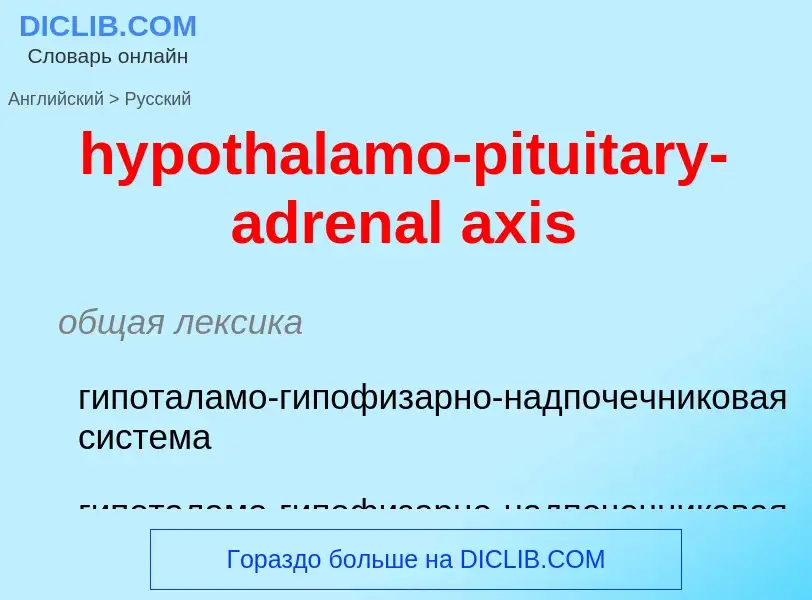Tradução e análise de palavras por inteligência artificial ChatGPT
Nesta página você pode obter uma análise detalhada de uma palavra ou frase, produzida usando a melhor tecnologia de inteligência artificial até o momento:
- como a palavra é usada
- frequência de uso
- é usado com mais frequência na fala oral ou escrita
- opções de tradução de palavras
- exemplos de uso (várias frases com tradução)
- etimologia
hypothalamo-pituitary-adrenal axis - tradução para russo
общая лексика
гипоталамо-гипофизарно-надпочечниковая система
гипоталамо-гипофизарно-надпочечниковая ось
общая лексика
надпочечник
медицина
гипоталамно-гипофизарный путь
Definição
Wikipédia
The hypothalamic–pituitary–gonadal axis (HPG axis, also known as the hypothalamic–pituitary–ovarian/testicular axis) refers to the hypothalamus, pituitary gland, and gonadal glands as if these individual endocrine glands were a single entity. Because these glands often act in concert, physiologists and endocrinologists find it convenient and descriptive to speak of them as a single system.
The HPG axis plays a critical part in the development and regulation of a number of the body's systems, such as the reproductive and immune systems. Fluctuations in this axis cause changes in the hormones produced by each gland and have various local and systemic effects on the body.
The axis controls development, reproduction, and aging in animals. Gonadotropin-releasing hormone (GnRH) is secreted from the hypothalamus by GnRH-expressing neurons. The anterior portion of the pituitary gland produces luteinizing hormone (LH) and follicle-stimulating hormone (FSH), and the gonads produce estrogen and testosterone.
In oviparous organisms (e.g. fish, reptiles, amphibians, birds), the HPG axis is commonly referred to as the hypothalamus-pituitary-gonadal-liver axis (HPGL-axis) in females. Many egg-yolk and chorionic proteins are synthesized heterologously in the liver, which are necessary for ovocyte growth and development. Examples of such necessary liver proteins are vitellogenin and choriogenin.
The HPA, HPG, and HPT axes are three pathways in which the hypothalamus and pituitary direct neuroendocrine function.



![under the microscope]], showing its different layers. From the surface to the center: zona glomerulosa, zona fasciculata, zona reticularis, medulla. In the medulla, the central adrenomedullary vein is visible. under the microscope]], showing its different layers. From the surface to the center: zona glomerulosa, zona fasciculata, zona reticularis, medulla. In the medulla, the central adrenomedullary vein is visible.](https://commons.wikimedia.org/wiki/Special:FilePath/Adrenal cortex labelled.jpg?width=200)

![file description page in Wikimedia Commons.]]</ref> file description page in Wikimedia Commons.]]</ref>](https://commons.wikimedia.org/wiki/Special:FilePath/Incidences and prognoses of adrenal tumors.png?width=200)
![Characteristic skin [[hyperpigmentation]] in [[Addison's disease]] Characteristic skin [[hyperpigmentation]] in [[Addison's disease]]](https://commons.wikimedia.org/wiki/Special:FilePath/T. Addison; On...supra-renal capsules Wellcome L0018484.jpg?width=200)

![[[Sagittal]] section of the pituitary gland, showing the infundibulum [[Sagittal]] section of the pituitary gland, showing the infundibulum](https://commons.wikimedia.org/wiki/Special:FilePath/Gray1180.png?width=200)
